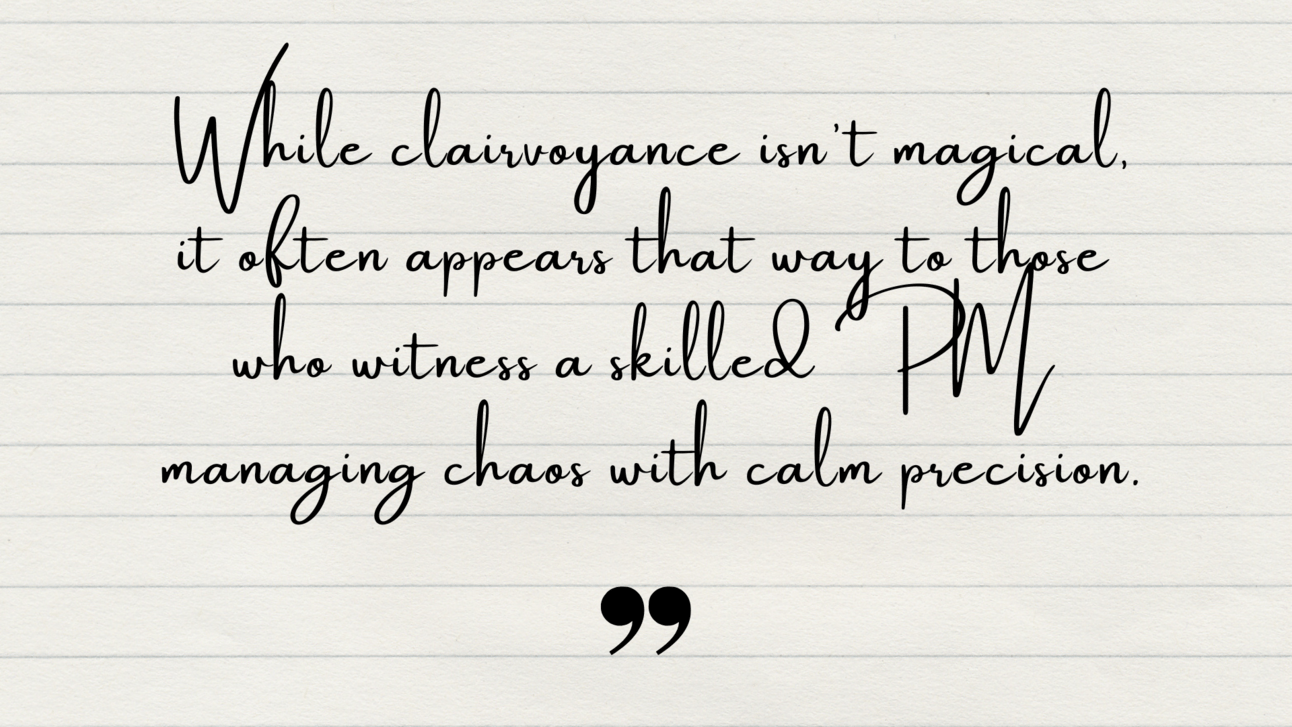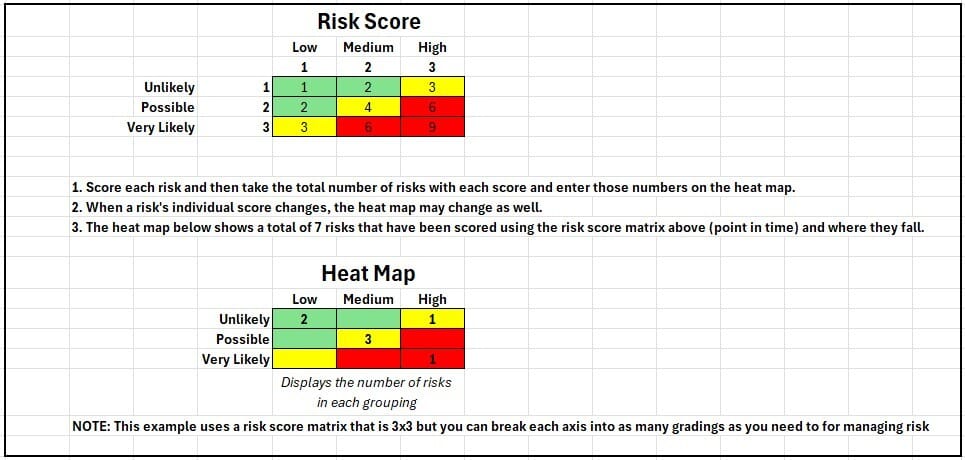Claire: fictional, but not irrelevant. As PMs, we should emulate her.

You’d likely agree that project management is equal parts science and art, right?
Among the various skills a PM must cultivate, I could argue that "clairvoyance"—the ability to anticipate challenges and foresee potential outcomes—is one of the most vital.
While project managers don't need extrasensory perception (ESP), they do need to develop a heightened ability to "see around corners," predicting challenges and planning for multiple possible futures.
This trait allows them to navigate complexities, mitigate risks, and keep their projects on track, earning the trust of stakeholders and team members alike.
It’s akin to when your “spidey senses” are tingling.
Like Claire, we should develop clairvoyance, as it plays a critical role in project management.
Be Like Claire
The Essence of Clairvoyance in Project Management
Clairvoyance, in the context of project management, refers to the ability to anticipate risks, identify opportunities, and forecast potential outcomes before they occur. This foresight allows us to design contingency plans, align resources, and maintain control over the project's trajectory.

How Successful PMs Exhibit Clairvoyance
… and I’ll ask - How are you doing with these techniques?
1. Identifying Risks Early: Spotting potential pitfalls long before they become critical issues.
2. Building Flexible Plans: Designing schedules and strategies that can adapt to unforeseen challenges.
3. Communicating Proactively: Keeping teams and stakeholders informed to foster trust and preparedness.
⬆️These three are enablers to PM clairvoyance.
Clairvoyance in Risk Management
Risk management is one of the primary areas where clairvoyance shines. A project manager's ability to foresee risks and take preemptive action can mean the difference between project success and failure. This doesn’t mean you must do it on your own, either. Part of your job is to coach your team in identifying and calling out risks in a timely manner so they can be logged and managed successfully.
Practical Steps to Develop Risk Clairvoyance:
Conduct Thorough Risk Assessments
Begin every project with a detailed risk assessment. Identify potential risks across all categories—technical, financial, operational, and external. When you ask yourself or your team if there are any risks, the answer might not come easily.
This is where you need to dig deeper to find them. Ask the team what they’ve seen go wrong with the same type of project in the past. Something should bubble up. Once one does, several more are likely to appear.
Use tools like SWOT analysis (Strengths, Weaknesses, Opportunities, Threats) or risk heat maps to visualize and prioritize risks.
SWOT analysis is a powerful tool for assessing internal and external factors that may influence your project. By identifying strengths, weaknesses, opportunities, and threats, you can develop strategies with your stakeholders to appropriately deal with each.
A risk heat map shows how many risks you have in each severity level.

Risk Rating versus Risk Heat Map
Learn from the Past
Reviewing lessons learned from previous projects can allow you to see patterns of risk, as they often repeat themselves in similar contexts. Create a "risk library" documenting past challenges and how they were mitigated.
Stay Informed
Keep a pulse on industry trends, regulatory changes, and market conditions. Being well-informed enhances your PM clairvoyance!
Engage Stakeholders
Involve stakeholders in risk identification. Different perspectives can uncover risks you might not have considered.
Maintain open communication to ensure everyone is aligned on risk management strategies.
Clairvoyance in Proactive Scheduling
Proactive scheduling is another domain where clairvoyance proves invaluable. We don’t want to just plan for what is likely to happen—we prepare for what could happen, both good and bad. This mindset allows for flexibility and resilience in project timelines.
Practical Steps to Develop Scheduling Clairvoyance:
Scenario Planning:
Develop multiple scenarios for your project timeline. Consider best-case, worst-case, and most-likely scenarios.
Create "if-then" plans for each scenario to ensure you're prepared for deviations from the original schedule.
Buffer Time
Build buffer time into your schedule for critical tasks. This safety margin helps absorb delays without derailing the entire project.
Dependency Mapping
Identify dependencies between tasks and assess their potential impact on the timeline. This helps you anticipate bottlenecks and address them proactively.
Leverage Technology
Use project management software to monitor progress in real time. Tools like Gantt charts, critical path analysis, and timeline simulations can provide valuable insights.
Regularly Update the Schedule
Treat your project schedule as a living document. Regular updates based on new information ensures it remains realistic and actionable.
Cultivating the Clairvoyant Mindset
Clairvoyance is not an innate talent—it’s a skill that can be cultivated through deliberate practice and continuous learning. Here are practical ways to sharpen your foresight as a project manager:
Stay Curious
Develop a curious mindset. Ask "what if" questions to explore different possibilities and outcomes.
Dive deep into the details while keeping an eye on the bigger picture.
Embrace Data-Driven Decision-Making
Use data and analytics to identify trends and patterns that can inform your predictions. Historical data is a goldmine for anticipating future challenges.
Develop Emotional Intelligence
A keen understanding of team dynamics and stakeholder motivations can help you anticipate interpersonal conflicts and address them proactively.
Expand Your Knowledge Base
Invest in continuous learning. Attend workshops, read industry literature, and seek mentorship to stay ahead of the curve.
Practice Reflective Thinking
After every project, take time to reflect. Analyze what went well, what didn’t, and what you could have foreseen.
Foster a Culture of Transparency
Create an environment where team members feel safe to share concerns and insights. Collaboration often uncovers risks and opportunities that might otherwise go unnoticed.
Applying Clairvoyance in Action
Clairvoyance isn't just about identifying risks or planning flexible schedules—it's about taking decisive action based on your foresight. Here’s how to apply this skill effectively:
Communicate Early and Often: Share your insights and contingency plans with stakeholders to build confidence and alignment.
Adapt Swiftly: When a predicted risk materializes, act quickly to implement your contingency plan. Agility is key to staying on track.
Celebrate Successes: When your clairvoyance leads to project success, acknowledge the effort and foresight involved. This reinforces the value of proactive management.

Your to-do list:
⏩If you're interested in the Project Management career field, DM me with questions on LinkedIn.
P.S. Embark on your project management journey today. "Inside the Project Manager's World" is your passport to a dynamic career path, providing insights, answers, and skills to propel you toward project management excellence.
P.P.S Like fun stuff?
👉 Celebrate your Project Management career with wearables and useful items here on TeePublic
P.P.P.S. (it’s a thing)
If you're interested in starting a newsletter like mine, try beehiiv (it's what I use)
